High-Cycle Fatigue Behavior of D2 Wheel Steel under Uniaxial and Multiaxial Loading Conditions for Potential Applications in the Railway Industry
Abstract
:1. Introduction
2. Experimental Procedure
SEM Analysis of Wheel Rim Cracking Behavior
3. Results and Discussion
3.1. Uniaxial Fatigue Crack Growth Threshold Test Results
3.2. Multiaxial Fatigue Crack Growth Threshold Test Results
3.3. SEM Analysis
4. Conclusions
- -
- The results of the uniaxial fatigue tests showed that the fatigue crack growth threshold for D2 wheel steel under uniaxial loading conditions ranged between 8–9 MPa.m0.5. Below this threshold, the crack growth rate decreased sharply, indicating the transition to threshold behavior. The number of cycles increased exponentially with decreasing ΔK, highlighting the sensitivity of D2 wheel steel to applied stress intensity factors in the threshold regime.
- -
- The multiaxial fatigue tests revealed that the FCGT for D2 wheel steel under multiaxial loading conditions ranged between 6–9 MPa.m0.5. A ΔK of 6 MPa.m0.5 resulted in over 1 million cycles without failure, indicating that this value was below the FCGT. The number of cycles sharply increased over 1 order of magnitude between ΔK values of 9 MPa.m0.5 to 6 MPa.m0.5, suggesting that the threshold lay within this range.
- -
- SEM analysis revealed differences in the crack propagation mechanisms between the uniaxial and multiaxial fatigue tests. In the uniaxial tests, the crack path deviated from its initial direction due to interactions with the microstructure. In the multiaxial tests, the crack propagated preferentially along planes of weakness in the material, following the loading direction. The analysis highlights the role of loading conditions in crack evolution.
- -
- The findings of this study may provide valuable insights into the fatigue behavior and damage mechanisms of D2 wheel steel under different loading conditions. The study determined the FCGT of D2 wheel steel and revealed how cracks initiate and propagate in D2 wheel steel under uniaxial and multiaxial loading. These insights can facilitate the development of safer and more reliable D2 wheel steel for high-speed rail applications. Future studies should focus on investigating the role of microstructure on the fatigue behavior of D2 wheel steel. Research can examine the effects of grain size, inclusion distribution and morphology, and material processing on crack initiation and growth. A deeper understanding of how microstructure influences fatigue can enable further optimization of D2 wheel steel for high-cycle applications. Furthermore, investigations of the behavior of D2 wheel steel under spectrum loading and variable amplitude loading conditions experienced in service can provide a more comprehensive understanding of the material’s damage evolution and failure mechanisms.
- -
- Finally, the results of this study may have practical implications for the railway industry. The determination of the fatigue crack growth threshold of D2 wheel steel may enable the optimization of wheelset designs to operate below the threshold and achieve maximum fatigue life, ultimately improving the safety and reliability of high-speed trains over long operational periods. Moreover, understanding the influence of microstructure and loading conditions on crack initiation and propagation in D2 wheel steel may inform processing and manufacturing techniques to produce materials with superior fatigue performance. Therefore, the findings of this study may provide a foundation for developing enhanced wheel steels and more durable wheelset designs to address issues such as rolling contact fatigue and rim cracking, thereby contributing to the advancement of the railway industry.
Author Contributions
Funding
Data Availability Statement
Conflicts of Interest
References
- Ruijie, Z.; Chunlei, Z.; Bo, L.; Xubiao, W.; Xiaofeng, L.; Yanguo, L.; Fucheng, Z. Research progress on rolling contact fatigue damage of bainitic rail steel. Eng. Fail. Anal. 2023, 143, 106875. [Google Scholar] [CrossRef]
- Xue, F. Investigation of rolling wheel–rail contact using an elaborate numerical simulation. Proc. Inst. Mech. Eng. Part F J. Rail Rapid Transit 2020, 234, 1198–1209. [Google Scholar] [CrossRef]
- He, C.; Zou, G.; Gan, Y.; Ye, R.; Zhai, Y.; Liu, J. Analysing the rolling contact damage behavior of a high-speed wheel tread—A case study. Wear 2023, 522, 204677. [Google Scholar] [CrossRef]
- Barke, D.W.; Chiu, W.K. A Review of the Effects of Out-Of-Round Wheels on Track and Vehicle Components. Proc. Inst. Mech. Eng. Part F J. Rail Rapid Transit 2005, 219, 151–175. [Google Scholar] [CrossRef]
- Giannakopoulos, A.; Lindley, T.; Suresh, S. Aspects of equivalence between contact mechanics and fracture mechanics: Theoretical connections and a life-prediction methodology for fretting-fatigue. Acta Mater. 1998, 46, 2955–2968. [Google Scholar] [CrossRef]
- Guo, K.; Gou, G.; Lv, H.; Shan, M. Jointing of CFRP/5083 Aluminum Alloy by Induction Brazing: Processing, Connecting Mechanism, and Fatigue Performance. Coatings 2022, 12, 1559. [Google Scholar] [CrossRef]
- He, J.-C.; Zhu, S.-P.; Luo, C.; Niu, X.; Wang, Q. Size effect in fatigue modelling of defective materials: Application of the calibrated weakest-link theory. Int. J. Fatigue 2022, 165, 10721. [Google Scholar] [CrossRef]
- Niu, X.; Zhu, S.-P.; He, J.-C.; Liao, D.; Correia, J.A.; Berto, F.; Wang, Q. Defect tolerant fatigue assessment of AM materials: Size effect and probabilistic prospects. Int. J. Fatigue 2022, 160, 106884. [Google Scholar] [CrossRef]
- Nejad, R.M.; Farhangdoost, K.; Shariati, M. Numerical study on fatigue crack growth in railway wheels under the influence of residual stresses. Eng. Fail. Anal. 2015, 52, 75–89. [Google Scholar] [CrossRef]
- Nejad, R.M. Using three-dimensional finite element analysis for simulation of residual stresses in railway wheels. Eng. Fail. Anal. 2014, 45, 449–455. [Google Scholar] [CrossRef]
- Suetrong, C.; Uthaisangsuk, V. Investigations of fatigue crack propagation in ER8 railway wheel steel with varying microstructures. Mater. Sci. Eng. A 2022, 840, 142980. [Google Scholar] [CrossRef]
- Lisowski, F.; Lisowski, E. Optimization of ER8 and 42CrMo4 Steel Rail Wheel for Road–Rail Vehicles. Appl. Sci. 2020, 10, 4717. [Google Scholar] [CrossRef]
- Costa, P.; Nwawe, R.; Soares, H.; Reis, L.; Freitas, M.; Chen, Y.; Montalvão, D. Review of Multiaxial Testing for Very High Cycle Fatigue: From ‘Conventional’ to Ultrasonic Machines. Machines 2020, 8, 25. [Google Scholar] [CrossRef]
- Li, X.-K.; Zhu, S.-P.; Liao, D.; Correia, J.A.; Berto, F.; Wang, Q. Probabilistic fatigue modelling of metallic materials under notch and size effect using the weakest link theory. Int. J. Fatigue 2022, 159, 106788. [Google Scholar] [CrossRef]
- Zhang, P.; Gao, Y.; Liu, Z.; Zhang, S.; Wang, S.; Lin, Z. Effect of cutting parameters on the corrosion resistance of 7A04 aluminum alloy in high speed cutting. Vacuum 2023, 212, 111968. [Google Scholar] [CrossRef]
- Zhu, T.; Ding, H.; Wang, C.; Liu, Y.; Xiao, S.; Yang, G.; Yang, B. Parameters Calibration of the GISSMO Failure Model for SUS301L-MT. Chin. J. Mech. Eng. 2023, 36, 20. [Google Scholar] [CrossRef]
- Dai, Z.; Xie, J.; Jiang, M. A coupled peridynamics–smoothed particle hydrodynamics model for fracture analysis of fluid–structure interactions. Ocean Eng. 2023, 279, 114582. [Google Scholar] [CrossRef]
- Liu, Y.; Li, J.; Lin, G. Seismic performance of advanced three-dimensional base-isolated nuclear structures in complex-layered sites. Eng. Struct. 2023, 289, 116247. [Google Scholar] [CrossRef]
- Zhang, S.; Han, B.; Zhang, T.; Chen, Y.; Xie, J.; Shen, Y.; Huang, L.; Qin, X.; Wu, Y.; Pu, K. High-temperature solid particle erosion characteristics and damage mechanism of AlxCoCrFeNiSi high-entropy alloy coatings prepared by laser cladding. Intermetallics 2023, 159, 107939. [Google Scholar] [CrossRef]
- Ekberg, A. Fatigue of Railway Wheels, Wheel–Rail Interface Handbook; Elsevier: Amsterdam, The Netherlands, 2009; pp. 211–244. [Google Scholar]
- Deng, X.; Qian, Z.; Li, Z.; Dollevoet, R. Investigation of the formation of corrugation-induced rail squats based on extensive field monitoring. Int. J. Fatigue 2018, 112, 94–105. [Google Scholar] [CrossRef]
- Bendikiene, R.; Bahdanovich, A.; Cesnavicius, R.; Ciuplys, A.; Grigas, V.; Jutas, A.; Marmysh, D.; Nasan, A.; Shemet, L.; Sherbakov, S.; et al. Tribo-fatigue Behavior of Austempered Ductile Iron MoNiCa as New Structural Material for Rail-wheel System. Mater. Sci. 2020, 26, 432–437. [Google Scholar] [CrossRef]
- Xu, J.; Wang, K.; Ma, Q.; Li, H.; Wang, P.; Chen, R.; Qian, Y.; Zeng, D. Study on acoustic emission properties and crack growth rate identification of rail steels under different fatigue loading conditions. Int. J. Fatigue 2023, 172, 107638. [Google Scholar] [CrossRef]
- Sun, Q.; Chen, C.; Liu, X. Comparative study of stator current-based and vibration-based methods for railway traction motor bearing cage fault diagnosis at high-speed condition. Struct. Health Monit. 2023, 22, 978–992. [Google Scholar] [CrossRef]
- Hao, R.-B.; Lu, Z.-Q.; Ding, H.; Chen, L.-Q. Orthogonal six-DOFs vibration isolation with tunable high-static-low-dynamic stiffness: Experiment and analysis. Int. J. Mech. Sci. 2022, 222, 107237. [Google Scholar] [CrossRef]
- Lu, Z.-Q.; Gu, D.-H.; Ding, H.; Lacarbonara, W.; Chen, L.-Q. Nonlinear vibration isolation via a circular ring. Mech. Syst. Signal Process. 2020, 136, 106490. [Google Scholar] [CrossRef]
- Luo, C.; Wang, L.; Xie, Y.; Chen, B. A New Conjugate Gradient Method for Moving Force Identification of Vehicle–Bridge System. J. Vib. Eng. Technol. 2022, 1–18. [Google Scholar] [CrossRef]
- Gu, M.; Cai, X.; Fu, Q.; Li, H.; Wang, X.; Mao, B. Numerical Analysis of Passive Piles under Surcharge Load in Extensively Deep Soft Soil. Buildings 2022, 12, 1988. [Google Scholar] [CrossRef]
- Li, Z.-Z.; Zhu, T.; Xiao, S.-N.; Zhang, J.-K.; Wang, X.-R.; Ding, H.-X. Simulation method for train curve derailment collision and the effect of curve radius on collision response. Proc. Inst. Mech. Eng. Part F J. Rail Rapid Transit 2023, 09544097231154313. [Google Scholar] [CrossRef]
- Yang, Y.; Lin, B.; Zhang, W. Experimental and numerical investigation of an arch–beam joint for an arch bridge. Arch. Civ. Mech. Eng. 2023, 23, 101. [Google Scholar] [CrossRef]
- Arslan, M.A.; Kayabaşı, O. 3-D Rail–Wheel contact analysis using FEA. Adv. Eng. Softw. 2012, 45, 325–331. [Google Scholar] [CrossRef]
- Kwon, S.-J.; Seo, J.-W.; Jun, H.-K.; Lee, D.-H. Damage evaluation regarding to contact zones of high-speed train wheel subjected to thermal fatigue. Eng. Fail. Anal. 2015, 55, 327–342. [Google Scholar] [CrossRef]
- Liu, C.; Cui, J.; Zhang, Z.; Liu, H.; Huang, X.; Zhang, C. The role of TBM asymmetric tail-grouting on surface settlement in coarse-grained soils of urban area: Field tests and FEA modelling. Tunn. Undergr. Space Technol. 2021, 111, 103857. [Google Scholar] [CrossRef]
- Jiang, J.; Ye, M.; Chen, L.; Zhu, Z.; Wu, M. Study on Static Strength of Q690 Built-up K-Joints under Axial Loads. In Structures; Elsevier: Amsterdam, The Netherlands, 2023; pp. 760–775. [Google Scholar]
- Xiao, X.; Zhang, Q.; Zheng, J.; Li, Z. Analytical model for the nonlinear buckling responses of the confined polyhedral FGP-GPLs lining subjected to crown point loading. Eng. Struct. 2023, 282, 115780. [Google Scholar] [CrossRef]
- Zhai, S.-Y.; Lyu, Y.-F.; Cao, K.; Li, G.-Q.; Wang, W.-Y.; Chen, C. Seismic behavior of an innovative bolted connection with dual-slot hole for modular steel buildings. Eng. Struct. 2023, 279, 115619. [Google Scholar] [CrossRef]
- Bosso, N.; Cantone, L.; Falcitelli, G.; Gjini, R.; Magelli, M.; Nigro, F.; Ossola, E.; Zampieri, N. Simulation of the thermo-mechanical behaviour of tread braked railway wheels by means of a 2D finite element model. Tribol. Int. 2023, 178, 108074. [Google Scholar] [CrossRef]
- Hong, H.; Kim, M.; Lee, H.; Jeong, N.; Moon, H.; Lee, E.; Kim, H.; Suh, M.; Chung, J.; Lee, J. The thermo-mechanical behavior of brake discs for high-speed railway vehicles. J. Mech. Sci. Technol. 2019, 33, 1711–1721. [Google Scholar] [CrossRef]
- Magelli, M. Development of a 2D finite element model for the investigation of the tread braked railway wheels thermo-mechanical behaviour. IOP Conf. Ser. Mater. Sci. Eng. 2022, 1214, 012041. [Google Scholar] [CrossRef]
- Deressa, K.T.; Ambie, D.A. Thermal Load Simulations in Railway Disc Brake: A Systematic Review of Modelling Temperature, Stress and Fatigue. Arch. Comput. Methods Eng. 2022, 29, 2271–2283. [Google Scholar] [CrossRef]
- Radu, S.M.; Popescu, F.D.; Andraș, A.; Virág, Z.; Brînaș, I.; Draica, M.-I. A Thermo-Mechanical Stress Based Fatigue Life Evaluation of a Mine Hoist Drum Brake System Using COMSOL Multiphysics. Materials 2022, 15, 6558. [Google Scholar] [CrossRef] [PubMed]
- Jiang, L.; Jiang, Y.-L.; Liang, Y.; Nan, S.; Ding, Y.-D. Thermal analysis for brake disks of SiC/6061 Al alloy co-continuous composite for CRH3 during emergency braking considering airflow cooling. Trans. Nonferrous Met. Soc. China 2012, 22, 2783–2791. [Google Scholar] [CrossRef]
- Liu, M.; Wang, J.; Zhu, H.; Krajnovic, S.; Zhang, Y.; Gao, G. A numerical study on water spray from wheel of high-speed train. J. Wind. Eng. Ind. Aerodyn. 2020, 197, 104086. [Google Scholar] [CrossRef]
- Chang, S.; Pyun, Y.-S.; Amanov, A. Wear Enhancement of Wheel-Rail Interaction by Ultrasonic Nanocrystalline Surface Modification Technique. Materials 2017, 10, 188. [Google Scholar] [CrossRef] [PubMed]
- Song, J.; Luo, S.; Liang, X.; Cao, Z.; Zhao, W.; Pu, C.; He, W. Rolling contact fatigue and damage characteristic of AISI 9310 steel with pre-laser shock peening treatment. Int. J. Fatigue 2022, 155, 106588. [Google Scholar] [CrossRef]
- Tian, Y.; Tan, Z.; Wang, J.; Wang, R.; Liu, Y.; Zhang, M. Experiment and finite element analysis of asymmetrical hardness induced by quenching in railway wheel. Eng. Fail. Anal. 2022, 133, 105959. [Google Scholar] [CrossRef]
- Lingamanaik, S.N.; Chen, B.K. Thermo-mechanical modelling of residual stresses induced by martensitic phase transformation and cooling during quenching of railway wheels. J. Mater. Process. Technol. 2011, 211, 1547–1552. [Google Scholar] [CrossRef]
- Zhang, Q.; Toda-Caraballo, I.; Li, Q.; Han, J.; Han, J.; Zhao, J.; Dai, G. Tension-shear multiaxial fatigue damage behavior of high-speed railway wheel rim steel. Int. J. Fatigue 2020, 133, 105416. [Google Scholar] [CrossRef]
- Cong, T.; Han, J.; Hong, Y.; Domblesky, J.P.; Liu, X. Shattered rim and shelling of high-speed railway wheels in the very-high-cycle fatigue regime under rolling contact loading. Eng. Fail. Anal. 2019, 97, 556–567. [Google Scholar] [CrossRef] [Green Version]
- Tunna, J.; Sinclair, J.; Perez, J. A review of wheel wear and rolling contact fatigue. Proc. Inst. Mech. Eng. Part F J. Rail Rapid Transit 2007, 227, 271–289. [Google Scholar] [CrossRef]
- Zhang, S.; Liu, Q.; Spiryagin, M.; Wu, Q.; Ding, H.; Wen, Z.; Wang, W. Gaps, challenges and possible solution for prediction of wheel–rail rolling contact fatigue crack initiation. Railw. Eng. Sci. 2023, 1–26. [Google Scholar] [CrossRef]
- Akama, M. Development of Finite Element Model for Analysis of Rolling Contact Fatigue Cracks in Wheel/Rail Systems. Q. Rep. RTRI 2007, 48, 8–14. [Google Scholar] [CrossRef] [Green Version]
- Chaimongkon, T.; Panich, S.; Uthaisangsuk, V. Anisotropic fracture forming limit curve and its applications for sheet metal forming with complex strain paths of aluminum sheet. Int. J. Adv. Manuf. Technol. 2021, 115, 3553–3577. [Google Scholar] [CrossRef]
- Ekberg, A.; Åkesson, B.; Kabo, E. Wheel/rail rolling contact fatigue–Probe, predict, prevent. Wear 2014, 314, 2–12. [Google Scholar] [CrossRef]
- Yong, N.; Kegang, L.; Deke, L.; Xianglong, L.; Shoujian, P. Experimental Investigation on Shock Mechanical Properties of Red Sandstone under Preloaded 3D Static Stresses. J. Eng. Sci. Technol. Rev. 2015, 8, 205–211. [Google Scholar] [CrossRef]
- Arfa, E.; Magnier, V.; Dufrénoy, P.; de Saxcé, G. Multi-scale Contact Approach Considering Material Heterogeneity and Wear. Tribol. Lett. 2021, 69, 135. [Google Scholar] [CrossRef]
- Sabato, A.; Niezrecki, C. Feasibility of digital image correlation for railroad tie inspection and ballast support assessment. Measurement 2017, 103, 93–105. [Google Scholar] [CrossRef]
- Nikas, D.; Ahlström, J.; Malakizadi, A. Mechanical properties and fatigue behaviour of railway wheel steels as influenced by mechanical and thermal loadings. Wear 2016, 366, 407–415. [Google Scholar] [CrossRef]
- Banerjee, U. Modeling damage mechanics of railway tracks to evolve control strategies for derailment prevention. Multidiscip. Model. Mater. Struct. 2013, 9, 341–358. [Google Scholar] [CrossRef]
- Ostash, O.P.; Anofriev, V.H.; Andreiko, I.; Muradyan, L.A.; Kulyk, V. On the concept of selection of steels for high-strength railroad wheels. Mater. Sci. 2013, 48, 697–703. [Google Scholar] [CrossRef]
- Ostash, O.; Kulyk, V.; Lenkovskiy, T.; Duriagina, Z.; Vira, V.; Tepla, T. Relationships between the fatigue crack growth resistance characteristics of a steel and the tread surface damage of railway wheel. Arch. Mater. Sci. Eng. 2018, 2, 49–55. [Google Scholar] [CrossRef]
- Gowtham, V.; Ranganathan, A.S.; Satish, S.; Alexis, S.J.; Kumar, S.S. Fatigue based design and analysis of wheel hub for Student formula car by Simulation Approach. IOP Conf. Ser. Mater. Sci. Eng. 2016, 149, 012128. [Google Scholar] [CrossRef]
- Suchý, L.; Hasse, A. Fatigue of multiaxially loaded shaft-hub connection under different load parameters. In Proceedings of the 8th International Conference on Fracture, Fatigue and Wear: FFW 2020, August 26–27 2020; Springer: Berlin/Heidelberg, Germany, 2021; pp. 473–487. [Google Scholar]
- Mangardich, D.; Abrari, F.; Fawaz, Z. A fracture mechanics based approach for the fretting fatigue of aircraft engine fan dovetail attachments. Int. J. Fatigue 2019, 129, 105213. [Google Scholar] [CrossRef]
- Venkatesh, P.; Kattimani, M.A.; Uddin, M.S.; Uddin, M.M. Evaluation of Fatigue Life of Nickel Alloy for Gas Turbines Hub. Evaluation 2022, 10, 2769–2774. [Google Scholar]
- Fu, Q.; Gu, M.; Yuan, J.; Lin, Y. Experimental Study on Vibration Velocity of Piled Raft Supported Embankment and Foundation for Ballastless High Speed Railway. Buildings 2022, 12, 1982. [Google Scholar] [CrossRef]
- Xiao, S.; Cao, Y.; Wu, G.; Guo, Y.; Gao, G.; Chen, S.; Liu, P.; Wang, Z.; Li, P.; Yu, J. Influence of the distributed grounding layout for intercity trains on the ‘train-rail’circumflux. IEEE Trans. Circuits Syst. II Exp. Briefs 2023, 70, 1194–1198. [Google Scholar] [CrossRef]
- Zhang, C.; Kordestani, H.; Shadabfar, M. A combined review of vibration control strategies for high-speed trains and railway infrastructures: Challenges and solutions. J. Low Freq. Noise Vib. Act. Control. 2023, 42, 272–291. [Google Scholar] [CrossRef]
- Bai, X.; Shi, H.; Zhang, K.; Zhang, X.; Wu, Y. Effect of the fit clearance between ceramic outer ring and steel pedestal on the sound radiation of full ceramic ball bearing system. J. Sound Vib. 2022, 529, 116967. [Google Scholar] [CrossRef]
- Fu, Z.; Yang, B.; Shan, M.; Li, T.; Zhu, Z.; Ma, C.; Zhang, X.; Gou, G.; Wang, Z.; Gao, W. Hydrogen embrittlement behavior of SUS301L-MT stainless steel laser-arc hybrid welded joint localized zones. Corros. Sci. 2020, 164, 108337. [Google Scholar] [CrossRef]
- Zhu, Q.; Chen, J.; Gou, G.; Chen, H.; Li, P. Ameliorated longitudinal critically refracted—Attenuation velocity method for welding residual stress measurement. J. Mater. Process. Technol. 2017, 246, 267–275. [Google Scholar] [CrossRef]
- Rackwitz, J.; Yu, Q.; Yang, Y.; Laplanche, G.; George, E.P.; Minor, A.M.; Ritchie, R.O. Effects of cryogenic temperature and grain size on fatigue-crack propagation in the medium-entropy CrCoNi alloy. Acta Mater. 2020, 200, 351–365. [Google Scholar] [CrossRef]
- Sausto, F.; Carrion, P.; Shamsaei, N.; Beretta, S. Fatigue failure mechanisms for AlSi10Mg manufactured by L-PBF under axial and torsional loads: The role of defects and residual stresses. Int. J. Fatigue 2022, 162, 106903. [Google Scholar] [CrossRef]
- Wu, S.; Li, C.; Luo, Y.; Zhang, H.; Kang, G. A uniaxial tensile behavior based fatigue crack growth model. Int. J. Fatigue 2020, 131, 105324. [Google Scholar] [CrossRef]
- Benedetti, M.; Santus, C. Mean stress and plasticity effect prediction on notch fatigue and crack growth threshold, combining the theory of critical distances and multiaxial fatigue criteria. Fatigue Fract. Eng. Mater. Struct. 2019, 42, 1228–1246. [Google Scholar] [CrossRef]
- D’elia, G.; Mucchi, E.; Dalpiaz, G. A novel methodology for dynamic response maximisation in multi-axis accelerated random fatigue testing. Mech. Syst. Signal Process. 2022, 181, 109491. [Google Scholar] [CrossRef]
- Wang, Y.; Zhang, X.; Su, Z.; Yao, W. Multiaxial fatigue life prediction based on single defect for additively manufactured 316L. Int. J. Fatigue 2022, 163, 107101. [Google Scholar] [CrossRef]
- Bold, P. Multiaxial Fatigue Crack Growth in Rail Steel. Ph.D. Thesis, University of Sheffield, Sheffield, UK, 1990. [Google Scholar]
- Engin, Z. Evaluation of Several Multiaxial High Cycle Fatigue Endurance Criteria. Master’s Thesis, Middle East Technical University, Ankara, Turkey, 2018. [Google Scholar]
- Liu, C.-P.; Liu, P.-T.; Pan, J.-Z.; Chen, C.-H.; Ren, R.-M. Effect of pre-wear on the rolling contact fatigue property of D2 wheel steel. Wear 2020, 442, 203154. [Google Scholar] [CrossRef]
- Liu, C.-P.; Pan, J.-Z.; Liu, P.-T.; Ren, R.-M.; Zhao, X.-J. Influence of original microstructure on rolling contact fatigue property of D2 wheel steel. Wear 2020, 456, 203380. [Google Scholar] [CrossRef]
- Kang, C.; Schneider, S.; Wenner, M.; Marx, S. Experimental investigation on the fatigue behaviour of rails in the transverse direction. Constr. Build. Mater. 2021, 272, 121666. [Google Scholar] [CrossRef]
- Tokaji, K.; Ko, H.-N.; Nakajima, M.; Itoga, H. Effects of humidity on crack initiation mechanism and associated S–N characteristics in very high strength steels. Mater. Sci. Eng. A 2003, 345, 197–206. [Google Scholar] [CrossRef]


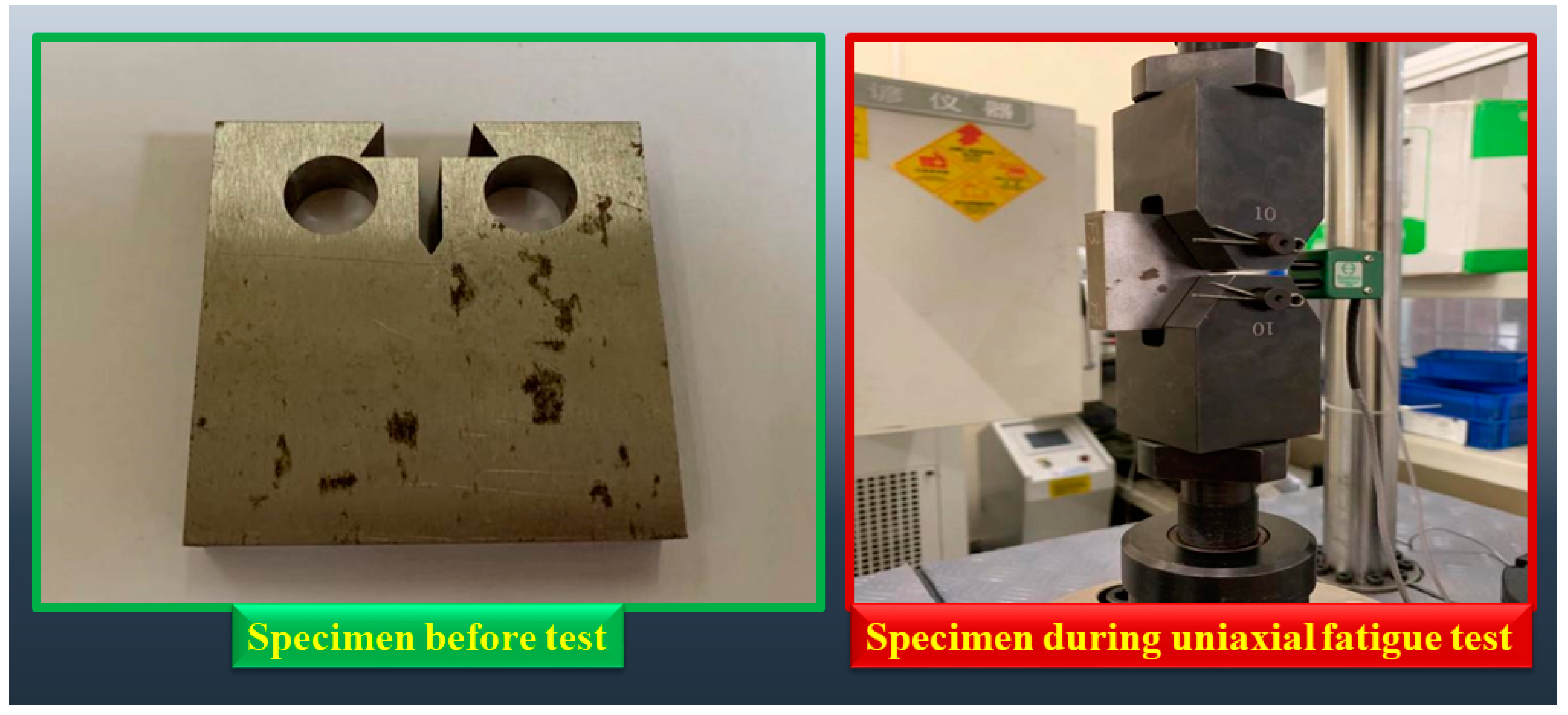
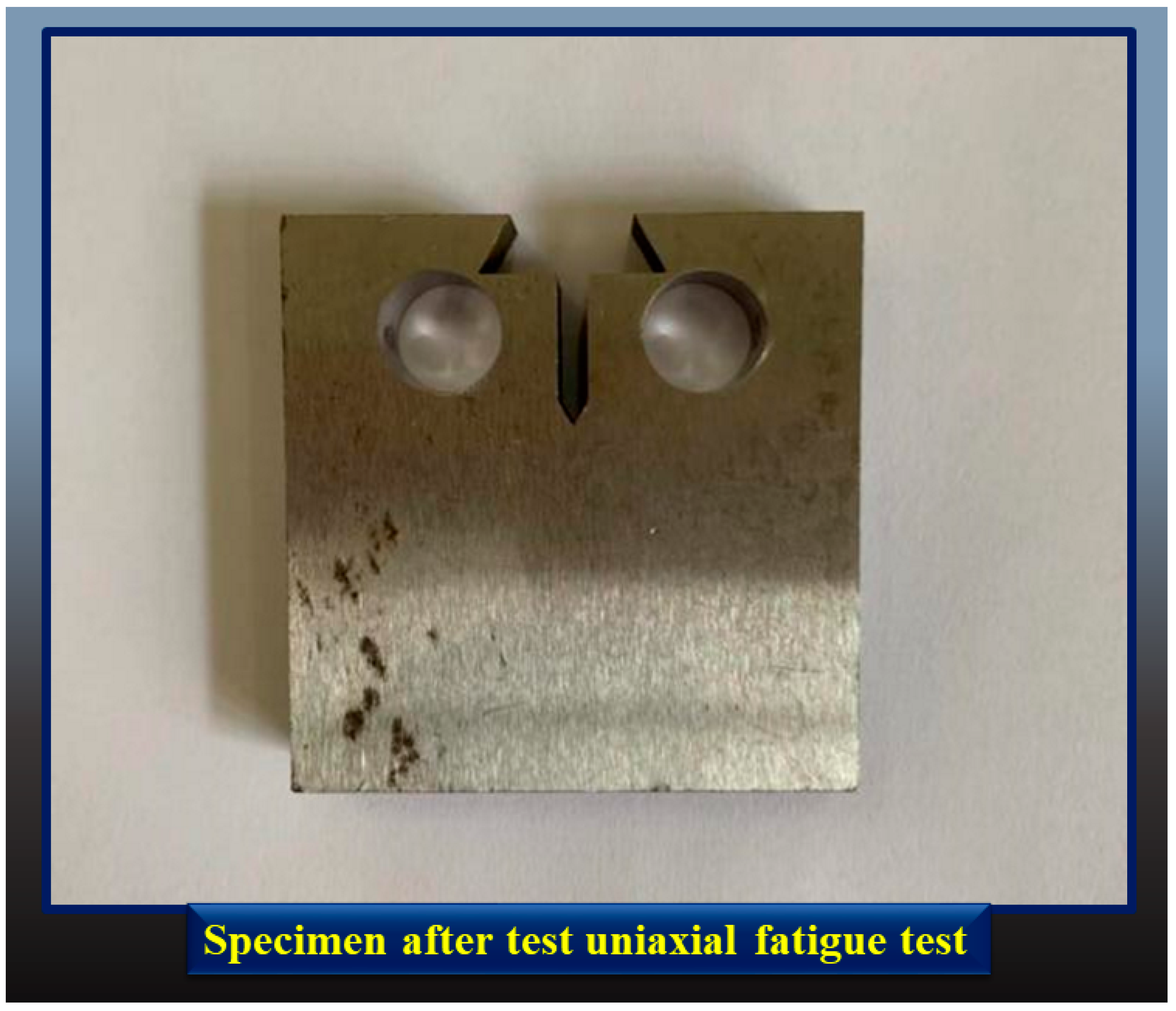
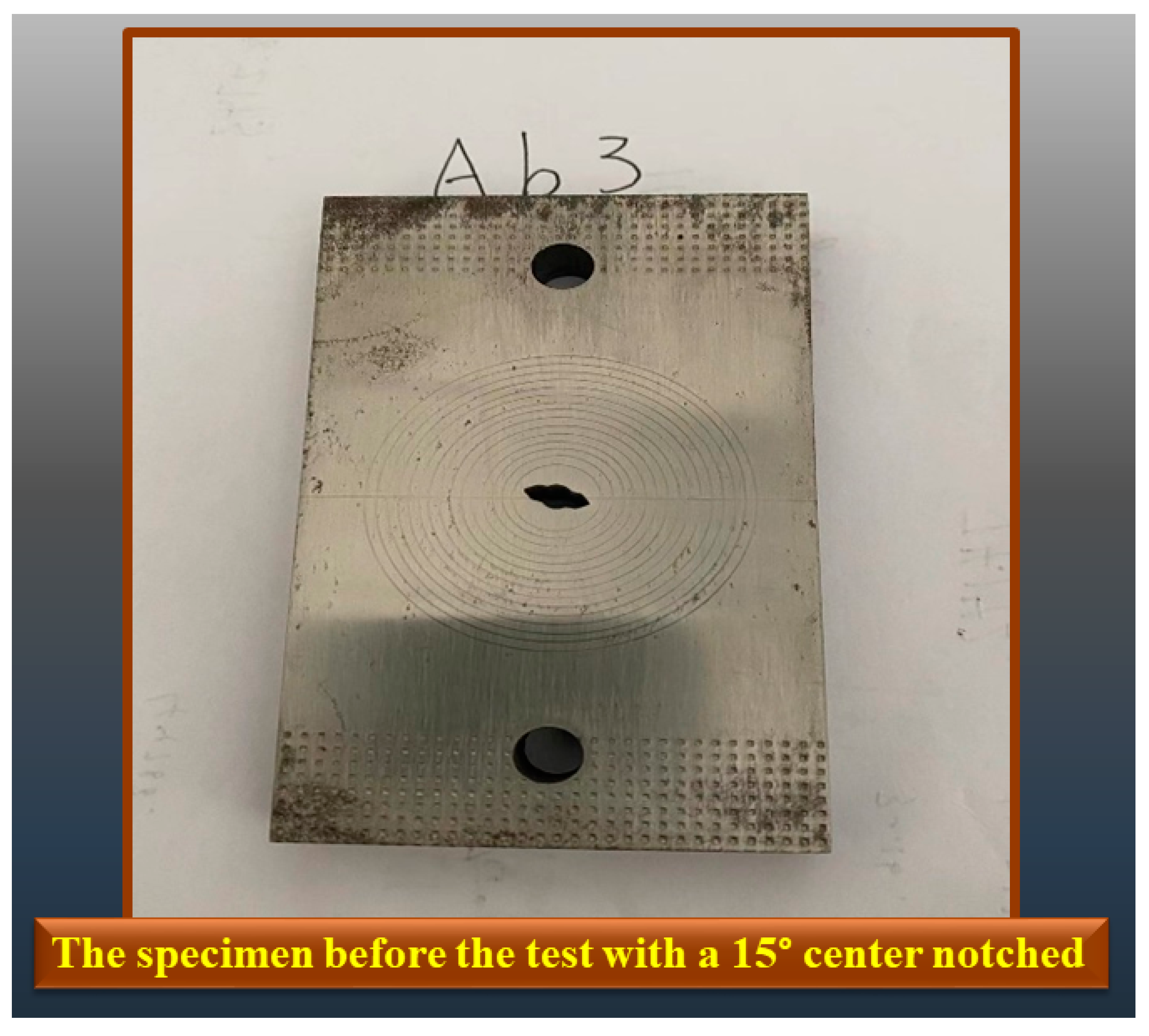

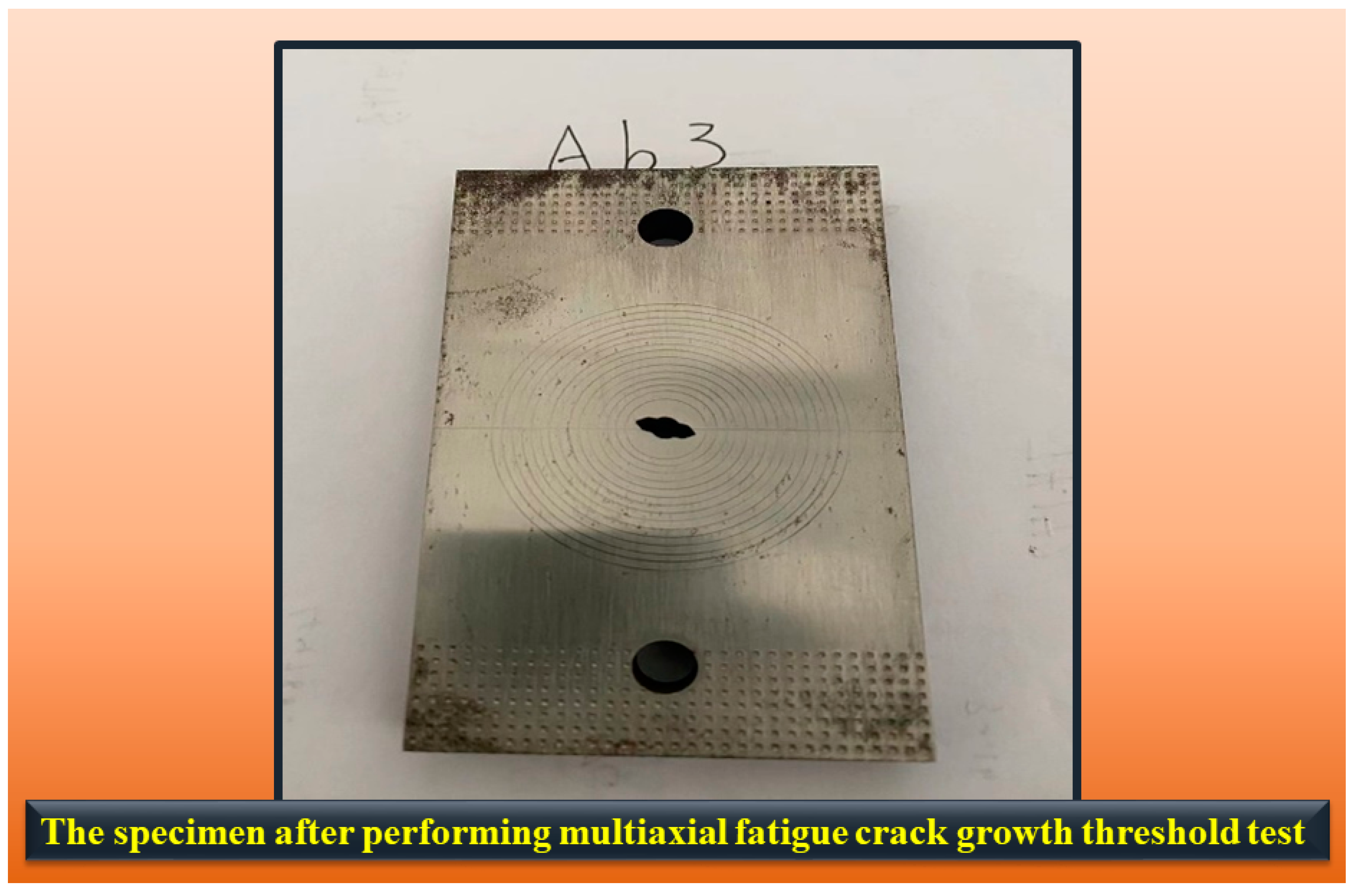
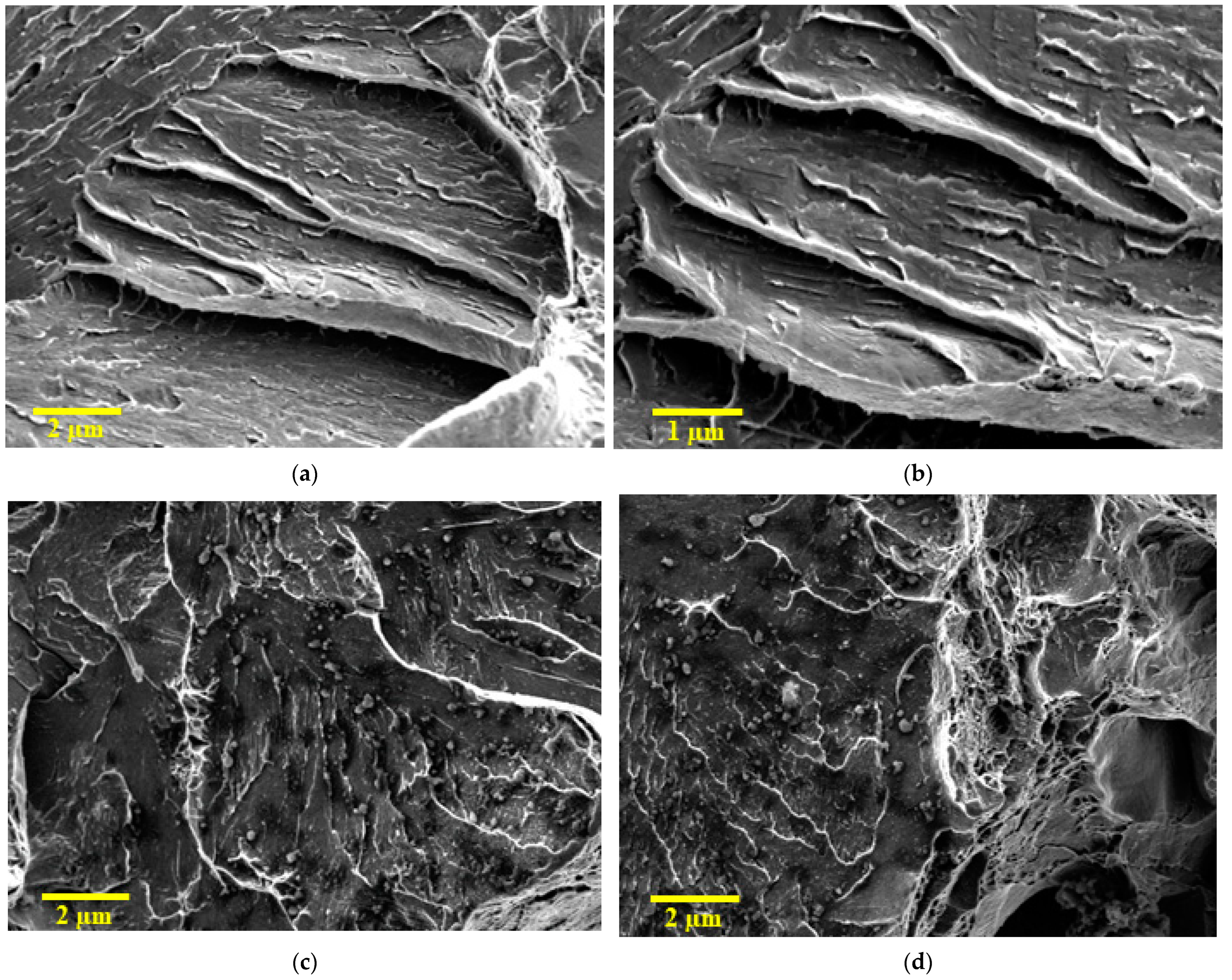
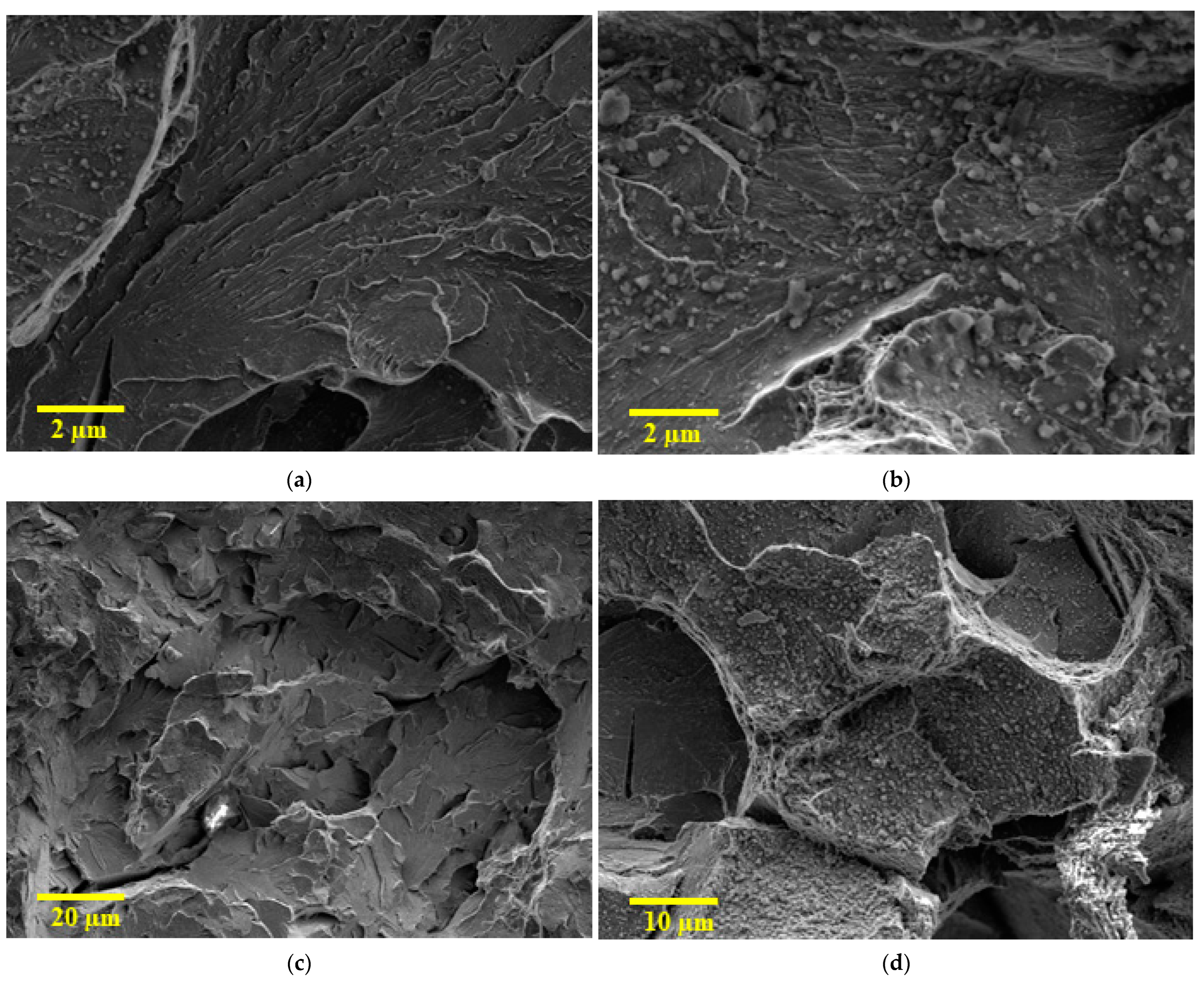
| Sample | Width(W) (mm) | Thickness(B) (mm) |
|---|---|---|
| CTR4 | 40 | 9.98 |
| Sample | Width(W) | Thickness (B) | Point of Impact Distance (mm) | The Angle of Central Notch (α) |
|---|---|---|---|---|
| Ab3 | 40 | 10 | 53.7 | 15° |
| Sample | W (mm) | B (mm) | Be (mm) | S (mm) | a0 (mm) | E (GPa) | Re (MPa) | Rm (MPa) |
|---|---|---|---|---|---|---|---|---|
| CTR4 | 40 | 9.98 | 9.98 | 200 | 8.00 | 225 | 580 | 940 |
| Data Counting | Cycle (C) | ΔK | Max (KN) | Min (KN) | Crack Length (mm) | Crack Growth Rate (10−7 m/C) | Time |
|---|---|---|---|---|---|---|---|
| 1 | 7489 | 11.000 | 5.291 | 0.531 | 9.037 | 0.000 | 16:54:35 |
| 2 | 12,278 | 11.000 | 5.249 | 0.571 | 9.088 | 1.787 | 16:55:39 |
| 3 | 18,255 | 11.000 | 5.339 | 0.487 | 9.138 | 1.433 | 16:56:59 |
| 4 | 25,370 | 11.000 | 5.307 | 0.517 | 9.188 | 1.223 | 16:58:34 |
| 5 | 30,190 | 11.000 | 5.330 | 0.494 | 9.239 | 1.810 | 16:59:38 |
| 6 | 38,041 | 11.000 | 5.310 | 0.508 | 9.289 | 1.120 | 17:01:23 |
| 7 | 43,351 | 11.000 | 5.255 | 0.561 | 9.342 | 1.664 | 17:02:34 |
| 8 | 52,425 | 10.780 | 5.172 | 0.506 | 9.392 | 0.973 | 17:04:36 |
| 9 | 53,028 | 10.780 | 5.121 | 0.443 | 9.443 | 14.521 | 17:04:44 |
| 10 | 60,369 | 10.780 | 5.123 | 0.463 | 9.493 | 1.233 | 17:06:23 |
| 11 | 68,162 | 10.780 | 5.118 | 0.466 | 9.544 | 1.165 | 17:08:08 |
| 12 | 76,566 | 10.780 | 5.120 | 0.464 | 9.594 | 1.086 | 17:10:01 |
| 13 | 85,224 | 10.780 | 5.19 | 0.461 | 9.645 | 1.060 | 17:11:57 |
| 14 | 92,904 | 10.780 | 5.122 | 0.456 | 9.695 | 1.202 | 17:13:40 |
| 15 | 99,807 | 10.564 | 4.4850 | 0.498 | 9.745 | 1.346 | 17:15:13 |
| 16 | 100,629 | 10.564 | 4.840 | 0.480 | 9.798 | 11.314 | 17:15:24 |
| 17 | 107,187 | 10.564 | 4.850 | 0.492 | 9.883 | 1.434 | 17:16:53 |
| 18 | 134,359 | 10.564 | 4.850 | 0.488 | 9.933 | 0.347 | 17:22:59 |
| 19 | 143,038 | 10.564 | 4.847 | 0.485 | 9.983 | 1.094 | 17:24:56 |
| 20 | 151,202 | 10.353 | 4.771 | 0.555 | 10.033 | 1.170 | 17:26:46 |
| 21 | 154,207 | 10.353 | 4.654 | 0.452 | 10.084 | 3.171 | 17:27:27 |
| 22 | 162,954 | 10.353 | 4.651 | 0.471 | 10.134 | 1.107 | 17:29:25 |
| 23 | 175,995 | 10.353 | 4.649 | 0.469 | 10.184 | 0.745 | 17:32:21 |
| 24 | 185,281 | 10.353 | 4.651 | 0.469 | 10.234 | 1.052 | 17:34:26 |
| 25 | 185,725 | 10.353 | 4.650 | 0.472 | 10.361 | 22.279 | 17:34:32 |
| 26 | 207,676 | 10.146 | 4.443 | 0.461 | 10.421 | 0.453 | 17:39:30 |
| 27 | 208,956 | 10.146 | 4.442 | 0.462 | 10.613 | 7.931 | 17:39:47 |
| 28 | 273,294 | 9.943 | 4.391 | 0.503 | 10.664 | 0.159 | 17:54:20 |
| 29 | 278,549 | 9.943 | 4.260 | 0.446 | 10.714 | 1.943 | 17:55:31 |
| 30 | 279,793 | 9.943 | 4.273 | 0.453 | 11.113 | 8.575 | 17:55:48 |
| 31 | 409,482 | 7.744 | 4.061 | 0.421 | 11.467 | 0.085 | 18:25:14 |
| 32 | 505,917 | 9.549 | 3.903 | 0.405 | 11.754 | 0.118 | 18:47:12 |
| 33 | 610,681 | 9.358 | 3.752 | 0.372 | 11.810 | 0.109 | 19:11:06 |
| 34 | 701,536 | 9.358 | 3.562 | 0.530 | 11.868 | 0.127 | 19:31:52 |
| 35 | 722,458 | 9.358 | 3.555 | 0.549 | 11.920 | 0.544 | 19:36:39 |
| 36 | 734,298 | 9.358 | 3.752 | 0.370 | 12.350 | 0.997 | 19:39:21 |
| 37 | 847,737 | 9.171 | 3.529 | 0.369 | 12.405 | 0.106 | 20:05:20 |
| 38 | 866,768 | 9.171 | 3.528 | 0.370 | 12.585 | 0.642 | 20:09:42 |
| 39 | 962,430 | 8.988 | 3.414 | 0.354 | 12.769 | 0.130 | 20:31:38 |
| 40 | 1,012,430 | 8.988 | 3.412 | 0.354 | 12.836 | 0.250 | 20:43:07 |
| 41 | 1,246,629 | 8.808 | 3.286 | 0.322 | 12.887 | 0.054 | 21:36:57 |
| 42 | 1,284,190 | 8.808 | 3.284 | 0.322 | 12.937 | 0.336 | 21:45:36 |
| 43 | 1,303,579 | 8.808 | 3.284 | 0.324 | 13.013 | 0.655 | 21:50:04 |
| 44 | 1,359,205 | 8.808 | 3.289 | 0.331 | 13.077 | 0.229 | 22:02:53 |
| 45 | 1,383,794 | 8.632 | 3.172 | 0.332 | 13.430 | 0.533 | 22:08:34 |
| 46 | 1,403,008 | 8.459 | 3.031 | 0.311 | 13.525 | 0.687 | 22:13:00 |
| 47 | 1,513,768 | 8.459 | 3.034 | 0.310 | 13.602 | 0.120 | 22:38:36 |
| 48 | 1,964,568 | 8.290 | 2.936 | 2.294 | 13.743 | 0.030 | 00:22:55 |
| 49 | 1,997,783 | 8.290 | 2.939 | 0.299 | 13.802 | 0.407 | 00:30:37 |
| 50 | 2,063,832 | 8.290 | 2.940 | 0.300 | 13.859 | 0.205 | 00:45:55 |
| 51 | 2,071,481 | 8.124 | 2.831 | 0.291 | 13.945 | 1.784 | 00:47:42 |
| 52 | 2,355,778 | 8.124 | 2.829 | 0.291 | 14.036 | 0.048 | 01:53:36 |
| 53 | 2,409,483 | 8.124 | 2.838 | 0.282 | 14.150 | 0.258 | 02:06:04 |
| 54 | 2,787,737 | 7.962 | 2.768 | 0.224 | 14.204 | 0.037 | 03:33:58 |
| 55 | 3,060,131 | 7.962 | 2.777 | 0.235 | 14.277 | 0.052 | 04:37:15 |
| 56 | 3,071,753 | 7.962 | 2.762 | 0.226 | 14.329 | 1.213 | 04:39:57 |
| 57 | 3,860,355 | 7.803 | 2.650 | 0.270 | 14.383 | 0.018 | 07:43:12 |
| 58 | 6,074,861 | 7.803 | 2.650 | 0.268 | 14.448 | 0.006 | 16:18:10 |
| K (MP.m0.5) | Static Load (N) | Dynamic Load (N) | N (Cycles) | A (Heads/Tails) |
|---|---|---|---|---|
| 11 | 21,334 | 21,334 | 122.5 k | 4.8/4.6 |
| 10.5 | 18,590 | 18,590 | 301.9 k | 5.8/5.7 |
| 10 | 16,106 | 16,106 | 462.0 k | 6.6/6.6 |
| 9.5 | 14,344 | 14,344 | 782.2 k | 7.9/7.7 |
| 9 | 12,663 | 12,663 | 895.6 k | 8.4/8.4 |
| 8.5 | 11,376 | 11,376 | 1349.2 k | 9.4/9.2 |
| 8 | 10,121 | 10,121 | 1841.1 k | 10.6/10.5 |
| 7.5 | 8935 | 8935 | 2656.7 k | 12/11.8 |
| 7 | 7838 | 7838 | 4085.3 k | 13/13.1 |
| 6.5 | 6837 | 6837 | 7111.5 k | 14/14 |
| 6 | 6133 | 6133 | 11,536.6 k | 15.1/15.1 |
Disclaimer/Publisher’s Note: The statements, opinions and data contained in all publications are solely those of the individual author(s) and contributor(s) and not of MDPI and/or the editor(s). MDPI and/or the editor(s) disclaim responsibility for any injury to people or property resulting from any ideas, methods, instructions or products referred to in the content. |
© 2023 by the authors. Licensee MDPI, Basel, Switzerland. This article is an open access article distributed under the terms and conditions of the Creative Commons Attribution (CC BY) license (https://creativecommons.org/licenses/by/4.0/).
Share and Cite
Li, S.; Zhao, Y. High-Cycle Fatigue Behavior of D2 Wheel Steel under Uniaxial and Multiaxial Loading Conditions for Potential Applications in the Railway Industry. Crystals 2023, 13, 1146. https://doi.org/10.3390/cryst13071146
Li S, Zhao Y. High-Cycle Fatigue Behavior of D2 Wheel Steel under Uniaxial and Multiaxial Loading Conditions for Potential Applications in the Railway Industry. Crystals. 2023; 13(7):1146. https://doi.org/10.3390/cryst13071146
Chicago/Turabian StyleLi, Shan, and Yongxiang Zhao. 2023. "High-Cycle Fatigue Behavior of D2 Wheel Steel under Uniaxial and Multiaxial Loading Conditions for Potential Applications in the Railway Industry" Crystals 13, no. 7: 1146. https://doi.org/10.3390/cryst13071146





